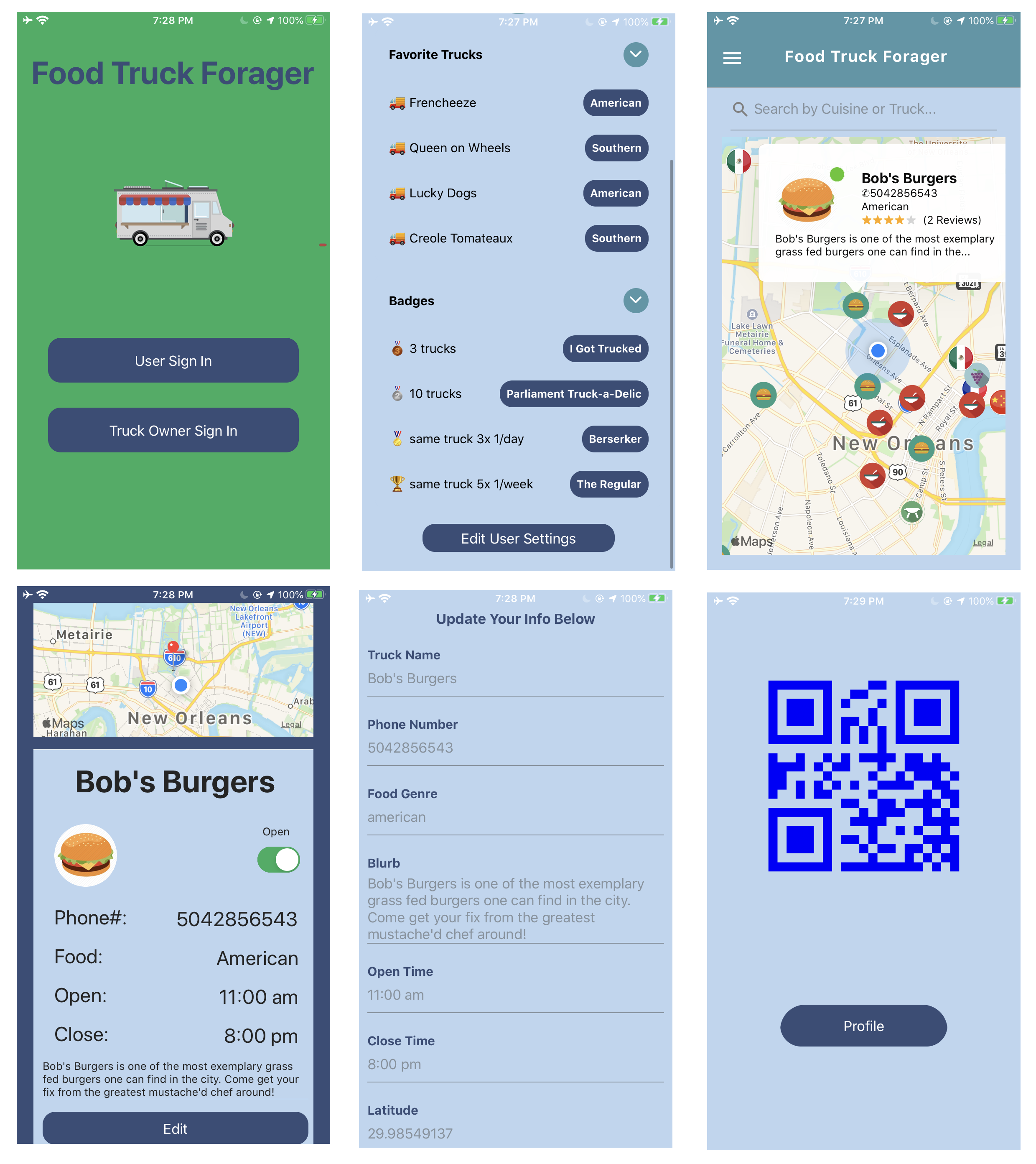Application for live tracking food trucks
Welcome to Food Truck Forager. Food Truck Forager provides users access to food trucks in their area. Food trucks load automatically as a user traverses to new areas within Google Maps or Apple Maps. Users can save their favorite trucks, review trucks, and earn achievements based on how often they visit food trucks via QR code scanning. Additionally, users can receive push notifications for trucks in their area! All photos uploaded are automatically tagged via machine learning AI image classification for screen reader accessibility options and photo content search. Food Truck Forager also allows food truck owners to create a business account and easily connect to current and potential customers. Truck owners can create posts and generate QR codes for user badge earning. Owners can also easily update their location on the map via marker dragging and update their open/closed status instantly.
- Babel
- Eslint
- Express
- Node
- Axios
- PostgreSQL
- Sequelize
- Expo
- React Native
- React Native Maps
- React Navigation
- React Native Paper
- TensorFlow.js
"dependencies": {
"@react-native-community/async-storage": "~1.11.0",
"@react-native-community/datetimepicker": "^2.4.0",
"@react-native-community/masked-view": "0.1.10",
"@react-navigation/native": "^5.7.3",
"@react-navigation/stack": "^5.9.0",
"@tensorflow-models/coco-ssd": "^2.1.0",
"@tensorflow/tfjs": "^2.3.0",
"@tensorflow/tfjs-backend-cpu": "^2.3.0",
"@tensorflow/tfjs-backend-webgl": "^2.3.0",
"@tensorflow/tfjs-core": "^2.3.0",
"@tensorflow/tfjs-react-native": "^0.3.0",
"axios": "^0.20.0",
"babel-plugin-inline-dotenv": "^1.6.0",
"cors": "^2.8.5",
"dotenv": "^8.2.0",
"expo": "~38.0.8",
"expo-barcode-scanner": "~8.2.1",
"expo-camera": "~8.3.1",
"expo-constants": "~9.1.1",
"expo-gl": "^8.3.1",
"expo-google-app-auth": "^8.1.2",
"expo-image-picker": "~8.3.0",
"expo-notifications": "~0.3.3",
"expo-permissions": "~9.0.1",
"expo-status-bar": "^1.0.2",
"expo-web-browser": "~8.3.1",
"express": "^4.17.1",
"fuzzy-search": "^3.2.1",
"jpeg-js": "^0.4.2",
"node-fetch": "^2.6.1",
"nodemon": "^2.0.4",
"pg": "^8.3.3",
"react": "~16.11.0",
"react-dom": "~16.11.0",
"react-native": "https://github.com/expo/react-native/archive/sdk-38.0.2.tar.gz",
"react-native-custom-qr-codes-expo": "^2.2.0",
"react-native-elements": "^2.3.2",
"react-native-fs": "^2.16.6",
"react-native-gesture-handler": "~1.6.0",
"react-native-maps": "0.27.1",
"react-native-masked-view": "^0.2.0",
"react-native-paper": "^4.2.0",
"react-native-qrcode-svg": "^6.0.6",
"react-native-reanimated": "~1.9.0",
"react-native-redash": "^8.0.0",
"react-native-safe-area-context": "~3.0.7",
"react-native-safe-area-view": "^1.1.1",
"react-native-screens": "~2.9.0",
"react-native-svg": "12.1.0",
"react-native-timeago": "^0.5.0",
"react-native-view-more-text": "^2.1.0",
"react-native-web": "~0.11.7",
"react-native-webview": "^9.4.0",
"react-native-word-cloud": "^1.0.7",
"react-navigation": "^4.4.0",
"react-navigation-drawer": "^2.5.0",
"react-navigation-stack": "^2.8.2",
"sequelize": "^6.3.4"
},
"devDependencies": {
"@babel/core": "^7.8.6",
"@types/react": "~16.9.41",
"@types/react-native": "~0.62.13",
"@typescript-eslint/eslint-plugin": "^3.10.1",
"@typescript-eslint/parser": "^3.10.1",
"eslint": "^7.7.0",
"eslint-config-airbnb-typescript": "^9.0.0",
"eslint-config-universe": "^4.0.0",
"eslint-plugin-import": "^2.22.0",
"eslint-plugin-jsx-a11y": "^6.3.1",
"eslint-plugin-react": "^7.20.6",
"eslint-plugin-react-hooks": "^4.1.0",
"typescript": "~3.9.5",
"husky": "^4.2.5"
},First, install PostgreSQL 12 on your machine: https://www.postgresql.org/download/
Then, use node -v to check your current version of Node. Upgrade to 12, if not currently on version 12.
Development:
npm install // installs dependencies
// go to /node_modules/react-native-material-textfield/src/components
// add '//' in front of line 27 in affix/index.js: // style: Animated.Text.propTypes.style,
// add '//' in front of line 13 in helper/index.js: // style: Animated.Text.propTypes.style,
// add '//' in front of line 32 in label/index.js: // style: Animated.Text.propTypes.style,
psql -U root // log in to postgreSQL with your password
CREATE DATABASE foodtruckdb; // create postgreSQL database
\c foodtruckdb; // connect to foodtruckdb database
npm run server // starts development server
npm run test-db // tests database commands and populates w/ sample data
expo start // runs compiler for Expo
Place in a .env file in outermost directory
env_variables:
GOOGLE_PLACES_API_KEY // Google Places API Credential
EXPO_iosClientId // Google Development Console iOS Client ID
EXPO_androidClientId // Google Development Console Android Client ID
EXPO_LocalLan // localLanAddress:ServerPort (find via ipconfig or ifconfig, default port:8080)
CLOUDINARY_NAME // name to use for Cloudinary image uploads
CLOUDINARY_URL // URL to use for Cloudinary image uploads
CLOUDINARY_API_KEY // key for Cloudinary image uploads
CLOUDINARY_API_SECRET // secret to use for Cloudinary image uploads
CLOUDINARY_UPLOAD_PRESET // preset for Cloudinary image uploads
DB_USERNAME // PostgreSQL login username
DB_PASSWORD // PostgreSQL password
DB_HOST // database host (default=localhost)
DB_PORT // database port (default=5432)
DB_DBNAME // database name (default=foodtruckdb)

